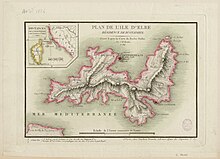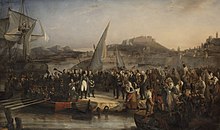Principality of Elba
You can help expand this article with text translated from the corresponding article in French. (February 2024) Click [show] for important translation instructions.
|
Principality of Elba Principato d'Elba (Italian) | |||||||||
|---|---|---|---|---|---|---|---|---|---|
| 1814–1815 | |||||||||
 Location of the Principality of Elba within Europe | |||||||||
| Capital | Portoferraio 42°49′N 10°19′E / 42.817°N 10.317°E | ||||||||
| Common languages | Italian, Elbano dialect | ||||||||
| Religion | Roman Catholic | ||||||||
| Demonym(s) | Elban | ||||||||
| Government | Absolute monarchy | ||||||||
| Sovereign Prince of Elba | |||||||||
• 1814–1815 | Napoleon | ||||||||
| Governor of Elba | |||||||||
• 1814–1815 | Antoine Drouot | ||||||||
| Historical era | Napoleonic Wars | ||||||||
| April 11, 1814 | |||||||||
| February 26, 1815 | |||||||||
| June 9, 1815 | |||||||||
| Currency | Tuscan lira | ||||||||
| |||||||||
| Today part of | Italy | ||||||||
The Principality of Elba (Italian: Principato d'Elba) was a non-hereditary monarchy established on the Mediterranean island of Elba following the Treaty of Fontainebleau on 11 April 1814. It lasted less than a year, and its only head was Napoleon Bonaparte, who would return to rule in France before his ultimate defeat and the dissolution of the principality.
Formation
[edit]
Sovereignty over the island, which until then had been part of the French département of Méditerranée, was given to Napoleon I of France after his abdication following the War of the Sixth Coalition. Article 3 of the treaty stipulated that Elba was to be "an independent principality possessed by him in complete sovereignty and as personal property".[1] His rule was to persist until his death, at which point control of the principality would pass to Tuscany. The former Emperor of the French was also granted a stipend of two million francs per year to be paid by France.
Napoleon's rule
[edit]In his few months on Elba, as well as creating a small navy and army, Napoleon developed the island's iron mines, oversaw the construction of new roads, issued decrees on modern agricultural methods, and overhauled the island's legal and educational system.[2][3]
Napoleon's residence
[edit]The Villa Napoleonica (or Villa San Martino) is one of the two residences occupied in Portoferraio by Napoleon Bonaparte during his exile on the Island of Elba, where it was his summer residence.[4] The second, the Palazzina dei Mulini, is located in the historic center of the town of Portoferraio, 3.5 km northeast of San Martino.[5]
In 1839, Anatole Demidoff, a Russian industrialist and patron, a great admirer of Napoleon and husband of a niece of the emperor, Princess Mathilde Bonaparte, had the Florentine architect Niccolò Matas build the Demidoff Gallery at the foot of the original building.[6]
-
Villa San Martino
-
Palazzina dei Mulini
Military
[edit]

As allowed by the Treaty of Fontainebleau, Napoleon brought 870 men to the island with him from France. The army was made up of 566 from the elite Garde Impériale (both infantry and cavalry) and the remaining 300 were from a small battalion of grenadiers. The army was under the supervision of General Antoine Drouot and commanded by General Pierre Cambronne and the staff headquarters. The navy consisted of 66 men and one ship: the double-masted, 18-gunned brig, Inconstant. A small flotilla of two other sloops also accompanied Inconstant. The fleet was first commanded by Lieutenant François-Louis Taillade; however, after nearly losing Inconstant in a storm, Taillade was replaced by Lieutenant Jean François Chautard, who would later ferry Napoleon back from Elba in 1815. Paoli Filidoro was appointed Captain of the Gendarmerie and operated under Giuseppe Balbiani as Intendant General. The combined armed forces by 1815 on Elba numbered about 1,000 men, costing over half of the island's treasury to pay, equip, and feed.
Dissolution
[edit]
On 26 February 1815, after ruling Elba for nearly 10 months, Napoleon escaped from the island and landed in southern France to retake power, beginning the War of the Seventh Coalition. After his defeat at the Battle of Waterloo, Napoleon was transported by Britain to the island of Saint Helena where he remained a prisoner until his death in 1821. At the Congress of Vienna, sovereignty of the island was transferred to the Grand Duchy of Tuscany.
Notes
[edit]- ^ Hicks 2014.
- ^ McLynn, Frank (1998). Napoleon: A Biography. Pimlico. p. 597. ISBN 978-0-7126-6247-5. ASIN 0712662472.
- ^ Latson, Jennifer (26 February 2015). "Why Napoleon Probably Should Have Just Stayed in Exile the First Time". Archived from the original on 25 June 2016.
- ^ napoleonsites 2020c.
- ^ napoleonsites 2020b.
- ^ napoleonsites 2020.
References
[edit]- Gruyer, Paul (1908). Napoleon, King of Elba. London: William Heinemann.
- Hicks, Peter (2014). "Napoleon On Elba – An Exile Of Consent". Napoleonica la Revue. 19: 53. doi:10.3917/napo.141.0053. Archived from the original on 1 May 2021.
- napoleonsites (2020). "La Galerie Demidoff à l'Île d'Elbe" [The Demidoff Gallery on the Island of Elba] (in French). Archived from the original on 30 December 2020.
- napoleonsites (2020b). "Le Palais des Mulini à Portoferraio" [The Mulini Palace in Portoferraio] (in French). Archived from the original on 30 December 2020.
- napoleonsites (2020c). "Villa San Martino on the Island of Elba". Archived from the original on 30 December 2020.




